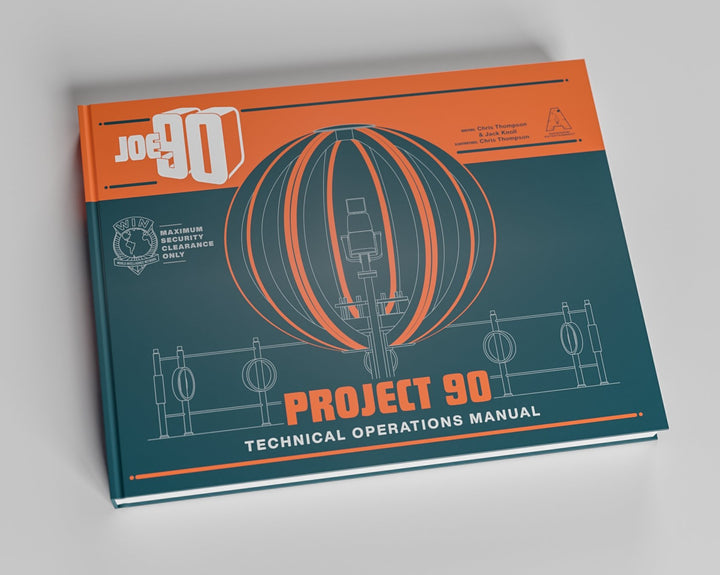The Second Countdown: Exploring the Mystery of Thunderbirds' Brief Second Series

60 years since Thunderbirds first blasted off, the heroic adventures of International Rescue continue to enthral fans of several generations around the world. Retro television series with long-lasting popularity and sustained fandoms are common enough, but in Thunderbirds' case, it's all the more remarkable given that the series' lifespan was so short.
Thunderbirds lasted for two series between 1965 and 1966. Its first series consisted of 26 episodes, while its second was a far more abrupt run of a mere 6 episodes. It's worth pausing for thought there and absorbing the possible implications and backstory of this bizarre figure, seemingly plucked out of thin air. 6 episodes? Really? It's a strikingly low figure that goes against accepted practice of how these series were produced.
Why exactly does Thunderbirds' second series consist only of six episodes? Let's investigate!
Supersonic Speculations

For such a miniscule figure to commission a second series of episodes for, precisely why Thunderbirds' second series was so short has mostly gone unacknowledged. This vacuum of background information has given rise to the false explanation that the second series was, in fact, meant to be much longer in episode numbers, but Lew Grade's notoriously mismanaged sale of Thunderbirds to the American market resulted in the series having its wings clipped.
Before we really begin excavating through what historical facts we can lay our hands on, we can put this long-lasting theory to bed. Thunderbirds' second series really was only produced as six episodes. Only 32 episodes of Thunderbirds were ever commissioned by ATV and 32 episodes were subsequently produced. The idea that further episodes had been greenlit but were abandoned holds little water for two simple yet definitive reasons - that wasn't how Lew Grade handled his various TV series, and no evidence has ever emerged as to what these 'lost' episodes may have been about.
To have commissioned further episodes only to halt their making mid-production would have been an embarrassing waste of time, resources and finances for all involved. Additionally, Thunderbirds benefits from an ever-continuing and meticulous unearthing of its production. No subsequent footage, scripts, or concept art from these supposed episodes have ever emerged - because they don't exist.
Now - on the small screen - again!
It's pretty concrete then that Thunderbirds' second series was always devised, produced and delivered as a compact package of six adventures, but the mystery as to why only six episodes still remains.

Some basic known facts are as follows: we know that Lew Grade had tremendous faith in Gerry Anderson and A.P. Films' growing track record of delivering superbly sophisticated sci-fi entertainment that continually proved successful with audiences and generated strong commercial value in overseas sales. It was a show of confidence then that Thunderbirds Are Go was announced to the press weeks before a single episode of the first series had even begun airing.
We also know that A.P. Films expanded its studios on the Slough Trading Estate to accommodate the simultaneous production of both the movie and this second run of TV episodes. This seemingly confirms that Thunderbirds' second series would have been greenlit around the same time as the first movie, all before Thunderbirds had revealed itself to the public.
The timing of these milestones then becomes a major factor in unravelling this mystery. If these six further episodes had been given the thumbs up around the same period as Thunderbirds Are Go, it begins to make more sense then if we think of Thunderbirds' second batch of episodes less as a second series and more an expansion of the first 26 episodes already produced. Grade has every right to be hugely confident in Thunderbirds' possible success. Supercar, Fireball XL5 and Stingray had brought Grade and ITC huge commercial and audience success and there was little reason to think that Thunderbirds' reception would be any different.
These extra six episodes enabled Thunderbirds to be presented to international markets as a 32-episode package, as well as a cinematic offering. Was Grade anticipating Thunderbirds' global success by presenting it as a colossal media brand with an extensive number of episodes and a movie to entice markets?
Grade's Gamble

In terrestrial broadcasting, television series tend to be greenlit with episode runs divisible by 13. This industry-standard figure defines practically all of Gerry Anderson's productions, which are often made up of TV series with either 26 or 39 episodes. Thunderbirds' costly production may have been a defining factor in its downfall, but its epic scale was also a canny move for its commercial viability. For its first series, Thunderbirds' hour-long episodes meant that the series could be, and was, sold as either 26 hour-long or 52 half-hour episodes - a handy way of filling out a year's worth of TV scheduling.
Thunderbirds' ballooning from 26 to 32 episodes appears to throw a spanner in this logic. 32 hour-long episodes (or 64 half-hours) may be an unusual overall figure within the demands of broadcasting, but then again, Thunderbirds wasn't an isolated case of an ITC TV series being sent out to the world with an unusual episode run. The Prisoner's run of 17 episodes is a notable example.
A likely answer may simply be that six episodes was the most agreeable figure in the context of A.P. Films' vastly expanded operations in early 1966. Both the second batch of episodes and the movie were produced in time for late 1966, suggesting that simultaneous work on Thunderbirds Are Go meant that only so much time could be devoted to a further run of episodes. The demands of Thunderbirds Are Go's production apparently resulted in the second series being produced at a more glacial pace compared to the first series, putting that six-episode run into further context.

Stretching Thunderbirds' run for an additional six episodes to be broadcast for the fall 1966 season may have been a seemingly shrewd move on Grade's part to make Thunderbirds a more appealing prospect for the all important American market. Speaking to Kinematograph Weekly in August 1965, Grade spoke in exuberant tones of Thunderbirds' sure-fire success - and that the series was being held back from being sold to America; "As for the States, we could have entered it (Thunderbirds) for the 1965 season, but we are definitely holding Thunderbirds back, because it will get an even better price when it goes into the 1966 selling season." Had Grade already greenlit Thunderbirds' six additional episodes by then, and was this the reason for doing so? Perhaps then these six extra episodes were produced with that fall season in mind as a modest batch of additional original material to showcase to the American market.
It's also worth taking note of how exactly we refer to Thunderbirds' additional episodes. It's rare for the series to actually be distinguished by its two series. Gerry and Sylvia Anderson's profile in The London Evening News from June 1967 refers to Thunderbirds not in the number of separate series, but in the overall number of episodes (although some series' episode numbers are miscounted!). "Our output includes 52 Four Feather Falls shows, 39 Supercars and 35 of Fireball XL5. It was after Lew bought the company that we went into colour. Then came 39 Stingrays, and finally, 32 hours of Thunderbirds." This lack of distinction between Thunderbirds' two series has subsequently fed into future media coverage and home media releases, constantly referring to Thunderbirds as an overall series of 32 episodes. Once again, 32 appears to have been the magic number for Thunderbirds.

By August 1966, it had become apparent that Thunderbirds' future, believed by Gerry to become the defining output of A.P. Films going forward, couldn't be justified. A new production would have to take its place; that series being Captain Scarlet and the Mysterons.
Pouring over what available evidence we can find, timing, budgets, and capacity would appear to be the defining factors in determining the brief lifespan of Thunderbirds' second batch of episodes. The many possible futures that Thunderbirds might have blasted off into remain intriguing to consider if the series had found more sustained success in America and on the big screen.

If that all-important American network TV sale had been secured, how would that have affected Thunderbirds' future on TV? Would a third series have been commissioned, and if so, how many episodes might it have lasted for? Or would any further episodes simply have been added onto the pre-existing six for the late 1966 season? Would future shorter runs of new episodes have become the norm had Thunderbirds Are Go been a bigger hit for A.P. Films and priorities shifted to ensuring Thunderbirds remained a big screen winner?
We may not be certain of the definitive answer as to why Thunderbirds' second series was so short, but with so many diverging factors pulling Thunderbirds in zigzagging directions, we may at least be more aware of why the answer may be so muddled.
Sign up to the Anderson Entertainment newsletter to receive all the latest Gerry Anderson news, exclusive releases and more transmitted direct to your inbox!




![Thunderbirds Comic Anthology Volume One [HARDCOVER] - The Gerry Anderson Store](http://gerryanderson.com/cdn/shop/files/thunderbirds-comic-anthology-volume-one-hardcover-8030771.jpg?v=1751089031&width=720)
![All Sections Alpha: The Making of Space: 1999 [HARDCOVER] - The Gerry Anderson Store](http://gerryanderson.com/cdn/shop/files/all-sections-alpha-the-making-of-space-1999-hardcover-7498116.png?v=1757766647&width=720)

![Stingray Comic Anthology Volume Two – Battle Lines [HARDCOVER] - The Gerry Anderson Store](http://gerryanderson.com/cdn/shop/files/stingray-comic-anthology-volume-two-battle-lines-hardcover-107681.jpg?v=1738856151&width=720)
![Stingray W.A.S.P. Technical Operations Manual Standard Edition [HARDCOVER] - The Gerry Anderson Store](http://gerryanderson.com/cdn/shop/files/stingray-wasp-technical-operations-manual-standard-edition-hardcover-112278.jpg?v=1749664163&width=720)
![Stingray WASP Technical Operations Manual Special Limited Edition [HARDCOVER BOOK] - The Gerry Anderson Store](http://gerryanderson.com/cdn/shop/files/stingray-wasp-technical-operations-manual-special-limited-edition-hardcover-book-991914.jpg?v=1749657538&width=720)
![Stingray: The Titanican Stratagem – Signed Limited Edition [HARDCOVER NOVEL] - The Gerry Anderson Store](http://gerryanderson.com/cdn/shop/files/stingray-the-titanican-stratagem-signed-limited-edition-hardcover-novel-129251.jpg?v=1740558711&width=720)








5 comments
I have always wondered why ATV Midlands spilt the episodes into two parts over two days on their original run. The other ITV regions didn’t do this. ATV viewers must have been a bit miffed about this. Its a pity Thundebirds could not have been networked on the ITV platform.
The second film Thunderbird 6 was shot alongside the final episodes of Captain Scarlet and the early episodes of Joe 90 after those 6 episodes Grade had planned for Thunderbirds to be for cinema with 2 films Supercar, Fireball XL5, Stingray had 39 half hours Captain Scarlet had 32 half hours and Joe 90 30 half hours and Grade had planned a 3 film deal with United Artists 2 Thunderbirds features and 2 feature films Starring Roger Moore as The Saint for the latter there was The Fiction Makers and a then new Saint novel that was published in 1964 Vendetta For The Saint both was switched to 2 part episodes of the TV series after the 2 Thunderbirds films flopped in 1968 this film would eventually made as a entirely new story called Crossplot financed by a loan from Grade which was on condition of them doing a series for Grade after that film. That series would be called The Persuaders.
Sounds like Grade messed up. Who orders a film to be made of a show that hasn’t even aired. And why not sell it to the U.S. the same year. Greed. “Thunderbirds” could have lasted until ‘69, incl. “Captain Scarlet”. It should have been the latter shooting in tandem. The fact that neither ran for at least 2 full seasons is ITC’s largest failure. Gerry & Sylvia had too good a crew and writing staff to be cut short; and the budget on “Joe 90” wasn’t high enough.
Such a great interesting story to read about and what a shame about Thunders Are Go.
There were 39 episodes each of Four Feather Falls, Supercar, Fireball XL5 & Stingray – not the output as stated in your article above